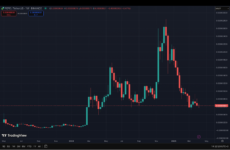BTC Bull Token rewards holders as Bitcoin hits price milestones. This guide explores BTCBULL’s price prediction through 2030.
What Is Pepe? Exploring the Meme Coin Phenomenon
Last Updatedby Tony Frank · 12 mins read

Pepe Coin began as a tribute to one of the internet’s most iconic memes — and quickly became a major force in the crypto world. This article traces PEPE’s rise from comic strip origins to blockchain phenomenon, covering its community-driven launch, tokenomics, market growth, and the powerful role of culture in shaping its value.
What began as a niche comic character in the mid-2000s has become a symbol of internet culture and, more recently, a force in the crypto economy. Pepe the Frog, once a laid-back meme shared between forums and message boards, has transformed into a decentralized asset with billions in market capitalization.
This journey — from comic panel to blockchain — reflects a broader cultural shift where memes, community, and speculation converge. The story of Pepe Coin isn’t just about a token — it’s about how internet-native ideas are increasingly shaping financial narratives.
The Origins. What is Pepe Meme Coin
Pepe Coin ( PEPE $0.000010 24h volatility: 2.5% Market cap: $4.15 B Vol. 24h: $939.69 M ) is more than just another meme coin built on the Ethereum blockchain — it’s the culmination of nearly two decades of internet culture, collective creativity, and community enthusiasm. It all began in 2005 when artist Matt Furie introduced Pepe the Frog, a laid-back cartoon character, in his indie comic, Boy’s Club. What started as a quirky drawing soon evolved into the Pepe the Frog internet meme — a symbol that would gain popularity across forums like 4chan, Reddit, and later, every major social media channel.

Source: Pepe Coin Official Website
What began as an innocent comic panel evolved rapidly into a viral meme. By the early 2010s, Pepe had become a digital canvas — endlessly reinterpreted to express every imaginable mood and reaction. The meme’s flexibility made it ubiquitous, spawning countless variations from “Sad Pepe” to “Smug Pepe” and becoming a lingua franca of internet culture.
History of Pepe the Frog Meme Cultural Impact
By the early 2010s, the Pepe the Frog internet phenomenon had firmly established itself across digital culture. Originally a quirky cartoon character, Pepe evolved into a global frog internet meme, gaining traction on platforms like Tumblr, Reddit, Twitter, and Instagram. His image — adaptable and emotionally rich — turned into a cultural canvas, with users remixing him to express everything from irony to despair. This level of transformation helped Pepe become more than just a meme — he became a digital symbol and one of the most enduring images in the history of the internet meme.
His unique ability to reflect the tone of each online space set Pepe apart. On Tumblr, he was stylized; on 4chan, weaponized; on Twitter, ironic and viral. His presence morphed in tandem with shifting internet subcultures. Unlike many memes that burn out quickly, Pepe continued to evolve — and that evolution would eventually carry him into the crypto world, where culture and finance began to merge.
Emergence of Pepe Coin in the Crypto Market
In 2023, Pepe Coin was born — a new chapter in the story of Pepe the Frog, this time in the heart of the crypto space. As a meme coin built purely on community hype and nostalgia, PEPE launched without a presale, team, or roadmap — just a token and a vision. The project was built on the Ethereum blockchain and thrived not on utility but on the symbolic weight of the meme itself.

PEPE Price Chart. Source: TradingView
Pepe Coin quickly gained popularity thanks to its raw, unfiltered energy. With explosive virality across social media channels and forums, Pepe Coin reached a multi-billion-dollar market cap within weeks. What made it compelling wasn’t what it did but what it represented: a decentralized joke-turned-movement in a market where attention drives value. The support from crypto enthusiasts and the broader crypto community transformed it from a meme into a phenomenon.
This enthusiasm wasn’t just spontaneous and powered by carefully orchestrated social media campaigns and grassroots memes. The launch reflected the chaotic spirit of the meme itself, and its success proved that, in the crypto world, storytelling can be as valuable as code.
Key Features of Pepe Coin
Despite its humorous tone, Pepe Coin introduced several strategic features that helped sustain momentum while encouraging long-term holding among existing token holders.
Deflationary Mechanism and Redistribution System
One of the foundational mechanisms of Pepe Coin is its burning mechanism, which is designed to create scarcity and strengthen the token’s value over time. Upon launch, a significant amount of supply was sent to a burn address, reducing the current circulating supply and increasing demand among collectors and speculators alike.
In tandem, the redistribution system incentivized user engagement by allocating portions of transaction volume to liquidity and holders — a mechanism that encouraged early supporters and enhanced community building. These tokenomics helped create a feedback loop between speculative energy and actual participation, solidifying PEPE’s position in the market.
No Tax Policy and Community-Driven Approach
Another defining characteristic of PEPE is its zero-tax policy. In contrast to many tokens that rely on transaction fees to support their ecosystems, Pepe Coin rejected that model entirely. This resonated with crypto enthusiasts disillusioned by complex tokenomics and hidden costs.
Without a central team or rigid development roadmap, PEPE flourished through grassroots momentum and community enthusiasm. It became a decentralized symbol of rebellion against the overly structured models dominating the crypto space. Initiatives like Pepe Academy — created by the community — played a pivotal role in educating newcomers and deepening engagement, further embedding the project within the fabric of the crypto community.
Market Performance and Capitalization
Pepe Coin’s entry into the market was nothing short of explosive. Within weeks of its launch in April 2023, PEPE surged to a multi-billion-dollar market cap, briefly positioning itself among the top three meme coins — alongside Dogecoin (DOGE) and SHIB $0.000011 24h volatility: 0.7% Market cap: $6.75 B Vol. 24h: $141.14 M . At its peak, the token’s capitalization crossed the $1.5 billion mark, driven almost entirely by retail enthusiasm, viral momentum, and speculative frenzy.
Trading volumes followed suit, regularly exceeding hundreds of millions of dollars daily on centralized exchanges and decentralized platforms like Uniswap. For a project with no utility, no team, and no official roadmap, this level of liquidity was unprecedented — and it underscored just how powerful meme-driven narratives could be in the current crypto cycle.
Compared to its predecessors, Pepe Coin carved out a unique niche. While DOGE $0.17 24h volatility: 0.8% Market cap: $24.81 B Vol. 24h: $977.55 M had Elon Musk and Shiba Inu positioned as a DeFi ecosystem, PEPE thrived purely on cultural capital. It wasn’t trying to build — it was trying to belong. And in a market increasingly driven by attention, that was enough to make it one of the fastest-growing tokens of the year.
Purchasing and Storing Pepe Coin
While purchasing Pepe Coin began as a novelty for meme lovers, its trading and storage infrastructure has quickly matured alongside its rise in the crypto market. Today, buying and holding PEPE is accessible even to first-time investors — though, as with any speculative asset, a basic understanding of best practices is essential. From choosing the right crypto exchange to securing tokens in a multi-sig wallet, careful handling is key for new and experienced token holders.
How to Buy Pepe Coin
Buying crypto like PEPE typically begins with selecting a trusted crypto exchange. Major platforms such as Binance, OKX, and Bybit have added PEPE to their exchange listings, allowing users to trade it against popular assets like ETH or USDT. These centralized exchanges offer a streamlined onboarding process: users must register, deposit funds, and execute a market or limit order.
Alternatively, those who prefer more control over their assets can purchase PEPE via decentralized platforms like Uniswap. In this case, it’s necessary to connect a compatible crypto wallet, such as MetaMask, and hold enough ETH to cover the transaction plus gas fees. Verifying the correct smart contract is critical to avoid counterfeit tokens — a frequent issue when meme coins see high daily trading volume.
In both scenarios, investors should be aware that only a small percentage of tokens may be available on exchanges at any given time, as a significant portion of supply could already be held by early adopters or stored in inactive wallets. This can impact price action and slippage, especially when attempting larger trades.
Secure Storage Solutions
After purchase, storing PEPE securely is crucial. While some may leave assets on an exchange for convenience, this exposes them to unnecessary custodial risk. A better alternative is moving the tokens into a secure wallet — either a hot wallet for active use or a cold wallet for long-term storage.
For maximum protection, many in the crypto community recommend using a multi-sig wallet or reputable hardware devices like Ledger and Trezor. These options ensure that private keys remain offline, protecting against malware, phishing, and unauthorized access. Users who actively engage in DeFi or trade frequently might prefer software wallets like MetaMask, Trust Wallet, or Rabby, which offer ease of use without sacrificing basic security.
Regardless of the method chosen, it’s important to regularly review your setup, back up recovery phrases securely, and understand where your remaining tokens are stored. In the volatile and fast-paced meme coin environment, safeguarding assets is as important as acquiring them.
Risks and Considerations in the Meme Coin Market
The meteoric rise of meme coins like Pepe Coin underscores one truth about the crypto market: narrative often outweighs fundamentals. While these tokens can deliver outsized returns in short bursts, they also carry heightened risk — largely due to extreme volatility and a lack of intrinsic value.
Meme coins are notoriously unpredictable. Prices can soar on the back of a viral tweet, a celebrity endorsement, or a sudden wave of retail FOMO — and crash just as quickly when attention fades. Unlike traditional crypto assets that offer utility, governance rights, or revenue mechanisms, many meme coins are driven purely by sentiment. Without a real product or use case, investor psychology becomes the only fuel for price movement.
Understanding the speculative nature of the meme coin space is essential for potential investors. These tokens are often launched without teams, roadmaps, or long-term vision. Liquidity can vanish overnight, and the line between community project and pump-and-dump is often blurry. While the upside can be massive, the downside is just as unforgiving.
Due diligence, position sizing, and a clear exit strategy aren’t optional here — they’re survival tools in one of the most volatile corners of the digital asset market.
Community Engagement and Social Media Influence
In the world of meme coins, community is everything — and Pepe Coin is no exception. From day one, its rise has been fueled not by corporate marketing budgets or VC backing but by the raw energy of the internet. Twitter, Telegram, Discord, and fringe platforms like 4chan were pivotal in turning PEPE from an inside joke into a multi-billion-dollar asset.
Memes, viral threads, and guerilla-style campaigns became the primary engines of growth. Users created artwork, remixed videos, and spammed comment sections of major influencers, exchanges, and crypto projects with Pepe imagery — flooding the algorithm with green frogs and pure enthusiasm. This grassroots movement wasn’t just marketing — it was identity-building.
PEPE’s decentralized, leaderless community gave it an authenticity that many polished crypto projects lack. Without a central figure dictating the narrative, anyone could contribute to the story — and that sense of ownership drove relentless engagement. In a space where attention equals value, Pepe Coin turned collective internet chaos into a powerful growth strategy.
Comparisons with Other Meme Coins
Pepe Coin inevitably draws comparisons to earlier meme coin giants — most notably, Dogecoin (DOGE) and Shiba Inu (SHIB). While all three share roots in internet culture and operate largely on the power of community, the paths they’ve taken — and the narratives they’ve built — reveal key differences.
Shiba Inu positioned itself as the “Dogecoin killer” with ambitions beyond memes. It introduced a complex ecosystem of tokens (LEASH, BONE), a decentralized exchange (ShibaSwap), NFT integrations, and even plans for a metaverse. The SHIB community, or “ShibArmy,” is structured, vocal, and often driven by long-term vision and ecosystem expansion.
In contrast, Pepe Coin took the opposite approach — leaning fully into its identity as a pure meme asset. It launched with no roadmap, no official team, and no promises. Its appeal lies in minimalism and chaos, echoing the early days of crypto where memes, speculation, and inside jokes ruled the day. This rawness attracted a different audience: one more interested in cultural resonance than utility.
Yet, despite the differences, both SHIB and PEPE prove the same point — that community and narrative can sometimes overpower traditional fundamentals. In a market increasingly driven by online attention and identity, meme coins are less about what they do and more about what they represent.
Conclusion
Pepe Coin stands as a testament to the chaotic power of the internet — a project born not from whitepapers or venture capital but from memes, momentum, and mass participation. Its success defies conventional metrics: no utility, no roadmap, no promises, and a vibrant ecosystem built purely on narrative.
Whether PEPE marks a turning point in how we value digital assets or simply a perfectly timed internet phenomenon, one thing is clear: in the attention economy of Web3, culture is currency — and Pepe is fluent in both.
Disclaimer: This article is for informational purposes only and does not provide financial, trading, or investment advice. Cryptocurrency prices can fluctuate wildly, and actual values may differ from PEPE predictions.
Always do your own research (DYOR), assess risks, and consult a professional before making financial decisions. The author and team are not responsible for any losses from using this information.
FAQ
What is Pepe Coin, and how did it originate?
Pepe Coin is a meme-based cryptocurrency launched in 2023 on the Ethereum blockchain, inspired by the iconic internet character Pepe the Frog, created by Matt Furie.
How does Pepe Coin operate within the crypto market?
It functions as a purely cultural asset with no utility or roadmap, relying on community hype, social media momentum, and speculative trading.
What are the key features that distinguish Pepe Coin from other meme coins?
PEPE features a deflationary supply model, a no-tax policy, and a decentralized, community-driven approach with no central team or formal development plan.
How can I buy Pepe Coin, and what should I consider before purchasing?
You can buy PEPE on major exchanges like Binance or via Uniswap; verify the token contract before purchasing and understand the high volatility typical of meme coins.
What is the significance of the no tax policy in Pepe Coin's ecosystem?
The no-tax policy reinforces its anti-establishment ethos and makes trading frictionless, appealing to users tired of overcomplicated tokenomics.
How does the deflationary mechanism impact the value of Pepe tokens?
By permanently burning a portion of the supply, the mechanism increases scarcity, which can help support price appreciation during periods of strong demand.
What are the risks associated with investing in meme coins like Pepe Coin?
Meme coins are highly speculative, subject to extreme volatility, and often lack intrinsic value, making them vulnerable to rapid price swings and liquidity drops.
How does the Pepe coin community influence its market performance?
The community drives visibility and demand through viral content, grassroots promotion, and meme propagation, creating self-reinforcing hype cycles.
What role do social media platforms play in the popularity of Pepe Coin?
Platforms like Twitter, Telegram, and Reddit amplify awareness and engagement, turning cultural momentum into market activity.
How does Pepe Coin compare to other meme coins like Shiba Inu regarding market cap and community support?
While Shiba Inu built an ecosystem with utility tokens and DeFi features, Pepe Coin relies entirely on cultural capital and raw community energy, yet still reached a comparable market cap during its early surge.
This guide is a must-read when joining the SNORT presale. Discover the Snorter Bot launch date and its projected exchange listings...
Bitcoin Hyper is a L2 for Bitcoin with dApp support. Its presale started on May 14, 2025, and is expected to end in Q3 or Q4. Lear...